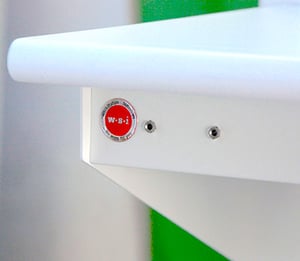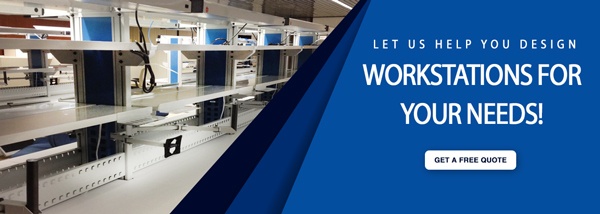As the demand for electronics continues to rise and technology evolves, the need for a dependable and functional assembly workstation is key to maintaining productivity.
Today’s electronic workstation benches must not only meet the needs of the technician, but also be flexible, address costly concerns and prioritize worker health.
When weighing your options, keep these design do’s and don’ts of an electronic workstation bench in mind to ensure you create the most efficient and functional work area for your space.
DO Address ESD Concerns
 Electrostatic discharge (ESD) is a major concern for companies that have electronic assembly operations.
Electrostatic discharge (ESD) is a major concern for companies that have electronic assembly operations.
ESD is a natural occurrence in which electricity is passed through the body or other conductor, and discharges onto an object. ESD can damage sensitive and expensive electronic components in electronics manufacturing and assembly.
In fact, static discharge can cause damage to sensitive devices with as little as 1 volt of electricity. Although people cannot feel static discharge until about 2,000 volts and higher, just because you do not feel a zap does not mean it didn’t occur and damage your assemblies.
To help protect your products, consider using an ESD workbench with other ESD components, such as an ESD laminate surface or an ESD chair, in your work area.
Although you can expect to pay about 15% to 30% more for an ESD product over its non-ESD counterpart, this level of protection is an important investment. Product loss due to damage from a static discharge can be more costly in the long run.
DON’T Choose The Wrong Materials
While ESD materials are often the best choice for electronic workstation benches, there are several other materials that may be appropriate for your product and better fit within your budget.
Butcher block, for example, is one of the most common materials found in manufacturing assembly workstations. This material is strong and durable, especially in basic assembly applications. However, it is not a good choice for environments that feature harsh conditions because liquid can cause the wood to warp and produce a buildup of mold and germs.
High pressure laminate (HPL) is also a durable choice for electronic workstation benches. Like butcher block, HPL laminate requires an environment free of harsh conditions. However, this material can withstand some heat (up to about 275 degrees for short periods of time) and comes in decorative options, adding aesthetics to a space.
There are several other types of high-quality materials available for your workstation, such as chemical resistant laminate and epoxy resin. However, unless your electronic assembly production also involves the use of high heat or damaging chemicals, these materials likely are not worth the cost of the extra protection.
DO Consider Employee Health
 Assembling electronics can be a time-intensive process that requires long periods of sitting. Considering sitting is the new smoking, medical issues can come at a heavy cost for employees and their employers.
Assembling electronics can be a time-intensive process that requires long periods of sitting. Considering sitting is the new smoking, medical issues can come at a heavy cost for employees and their employers.
Hydraulic adjustable workstations and benches are designed to provide flexibility to workers by allowing them to manage their environment and choose when they sit or stand. This helps reduce the risks associated with too much sitting.
Many also come with the ability to tailor the height of the workstation’s components to the worker. Adjustable components may include the keyboard, laptop and workstation tools.
The push for more ergonomically-designed features in workstations is growing, considering the U.S. Bureau of Labor Statistics reports that sprains, strains and tears collectively is the leading type of injury in manufacturing. In 2017, the median number of days missed by employees who experienced one of these injuries was 10.
DON’T Forget Accessories
Designing an electronic workstation bench or other laboratory workstations that are right for your space also involves making sure all your employee’s storage, organization and utility needs are met.
When sizing up their needs, look for drawers that:
- Are ergonomically-designed to both optimize workspace and help prevent repeated strains to the body
- Provide security, especially if you must store expensive tools
- Allows you to customize the configuration of the drawers based on how it benefits your employees most
Other organizational accessories you will want to consider for your design include:
- Shelving and upper cabinets
- Electrical power strips that can be mounted for easy access
- Pegboards that can hold tools
- Keyboard trays and articulating monitor arms
- Bin rails or panels that can hold parts and accessories
Finally, your electronic workstation bench design should also include utility options, such as a utility ductway for data, air and gas that can be attached to the upright. Proper lighting is also a critical tool needed during the assembly of electronics, which is why you should inquire about LED lighting. This can prevent the need for a desktop lamp, but provide extra lighting in addition to the ceiling lights.
DO Choose A Manufacturer Who Will Customize
In order to get the most out of your electronic workstation bench design, it is important to work with a company that specializes in customizing industrial workspaces.
Working with a company that creates a unique design that is meant to meet your individual needs will help ensure you have created a configuration best suited for your workspace. The best industrial furniture companies will:
- Work with you to determine your exact needs
- Help you improve workflow
- Determine which materials are best for your applications
- Emphasize safety and adhering to cleanliness requirements
- Provide you with a clear picture of how your workstation bench will function
- Offer options for reconfiguration of the workstation bench if needs change
A high-quality and experienced company will also ensure your design is completed and brought to life in a timely manner without sacrificing quality, safety or style.
Read more about why you should take advantage of customization opportunities in our article, Why Personalization Matters In An Industrial Furniture Company.


